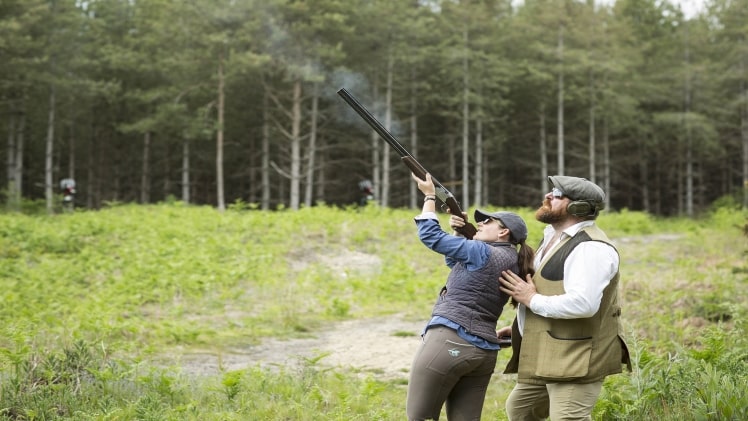What is Clay Pigeon Shooting?

Dirt Pigeon Shooting, otherwise known as Mud Sport Shooting, is a firing game where you shoot at unusual flying targets called clay pigeons or ground targets.
A phrase commonly used by dirt shooters, it regularly links to past times when live-pigeon competitions took place. Although such competitions were illegal in the United Kingdom in 1921, a target could be referred to as a “bird” in any case and the hit as a “kill.” And the missing target is called the “bird away.”
Before we get into the remaining of the article we would like to mention that one of the most important equipment required to enjoy clay pigeon shooting is the clay pigeon thrower. If you don’t have one then we highly recommend reading the full review of one of the best clay throwers: SME Manual Clay Target Thrower Review
History
At the beginning of 1875, land targets were introduced instead of live pigeons. Block-topped marks were later raised, although the name “soil targets” remained. In 1893, the Animate Bird Shooting Association was formed in England. In 1903 it changed its name to the Clay Bird Shooting Association. It had annual dirt pigeon-shooting challenges and lasted until World War I. In 1921, the British Parliament passed a bill making it illegal to shoot birds from the net.
Disciplines
There are at least 20 types of guided competitions in dirt pigeon shooting called divisions, although most are categorized under the primary headings of Trap, Skeet, and Sporting.
- The targets are sent entirely from a secluded “home” or machine, away from the shooter in trap shooting.
- The target is sent sideways from the two houses opposite the shooter in skeet shooting.
- Sporting clays include more mind-blowing lessons with multiple dispatch focus.
Sporting clays
This sport is one of the most extensive results in the English sports sector. While other trains use only standard focus, almost anything happens in sports. Objectives are thrown with unusual directions, points, rates, increments, and deflections. They are designed to mimic live mine shooting at the beginning of the discipline, with Spring Green Blue, Driven Chicken, Blasting Bunny, Pigeon Crossing, Duck Dropping, etc. The specialization in this conference includes English Sporting, donating worldwide (FITASC) sporting, a lot of branding sportswear and compact.
There may be infinite classifications of “standing” in this discipline. English donning is the most popular dirt shooting in the UK. A course or enmity consists of a certain number of stands, each with a predetermined number of targets, all moving in the same manner and at the same speed, singles, or copies.
Each stand highlights an alternative type of target: Crosser, Drive, Quartering. Global (FITASC) branding provide a more recognizable classification of focus as direction and speed and shoot 25 focus rounds simultaneously by a team of six rivals. The super Sporting is a crossover of the two precedent sorts. Additionally, there are various configurations. For example, the five enclosures in Compaq Wear and Sport strap are surrounded by different nets, and the shooters bake a diverse mixture or single from each residue, as shown before the enclosure.
Trapshooting
The target can be thrown single or copied from at least one of the nets set up about 15 meters before the shooter and disappear from the endpoint at most different rates, points, and lows. The most widely identified topics in this conference are:
- Down-the-line (DTL) single barrel
- Doubling growth
- Programmed Ball Trap (ABT)
- Olympic Net
- Double mesh
- Simple Gap
- Helice (or ZZ)
Skeet Shooting
Although the discipline began in America, skeet is an expression of Scandinavian beginnings. Targets are thrown in singles, and pairs from 2 net houses set exactly 40 meters apart on most sides of the crescent-shaped turn with seven shooting positions. Targets are thrown at specified directions and speeds. The primary subjects in this conference are the English skeet, Olympic skeet, and American (NSSA) skeet.
Under NSSA discipline, targets are distributed in a mix of singles and duplicates, from high and low sharehouses at appropriate directions and speeds, for a total of 25 targets per round. Classification is achieved by shooting around seven stations in a half-circle, one behind the eighth station between one and seven stations. Scoring is based on 1 point for each target killed up to 25.
In English skeet (the most famous skeet taught by a long shot), the gun’s position is discreet (i.e., ex-mounted or outside the shoulder when called target) and shooter call. But the goals are quickly delivered.
In Olympic skeet, targets travel at very high speeds, postponing the target’s arrival for up to 3 seconds after the call and requiring a shotgun down position. There is also an eighth shooting station between the two houses.
The English version of the NSSA also has the idea of skeet selection targets, where the shooter must redo the primary missed target. If the initial 24 goals are completely hit, the final goal is seen as an option.More informationhere electronic cigarette
Electrocibles or helicopter shooting
Beginning in Belgium in the 1960s, electrocibles were like net shooting, although they were made from a mud helicopter, giving the dust a staggered and singular. The chopper is white clay with two wings in the middle with a plastic propeller. Currently, this game is named Helicopter Shooting.
The plastic propeller with a detachable focal point rotates at high speed and is randomly distributed through one of the five nets. They fly in a flying manner; Humming through the so-called air. It was planned to be restored as an old game of live pigeon shooting. ZZ’s extraordinary name comes from the innovator who made them from zinc, and as of late, a unique kind of pigeon called zurito; Hence the term zinc zurito. FITASC coordinates the World and European Championships each year.





